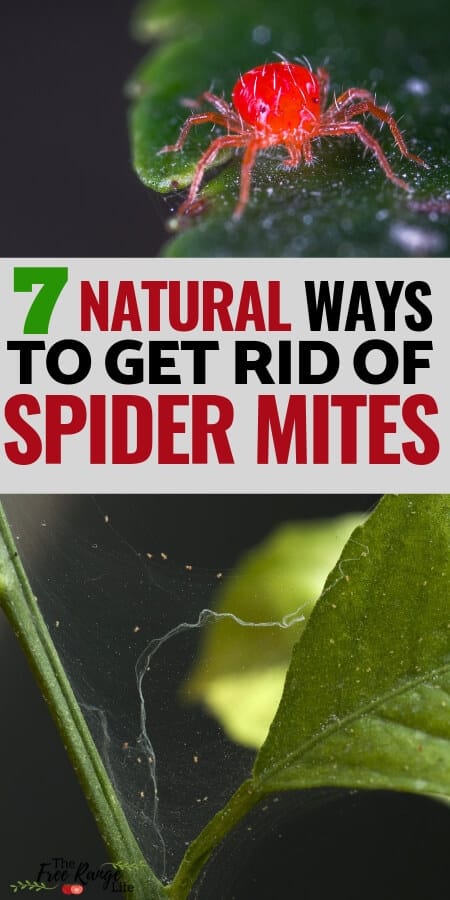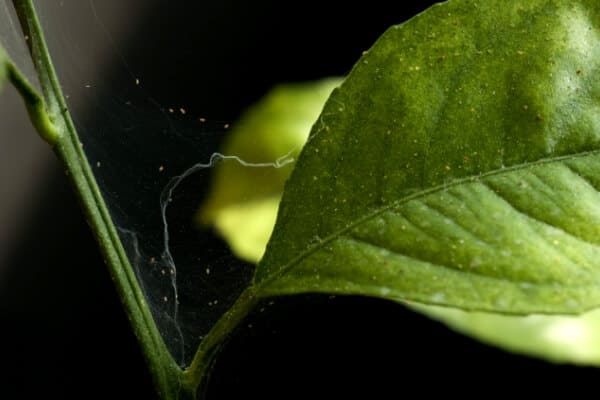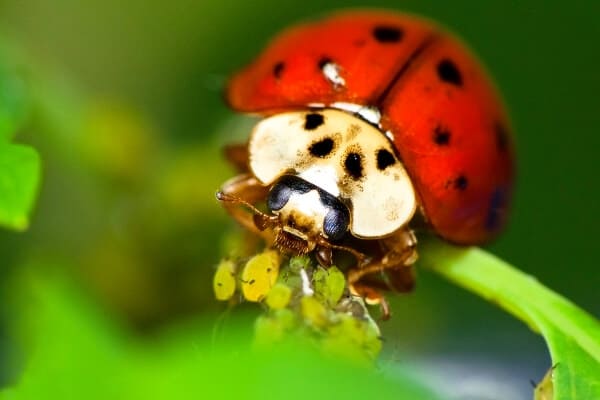In this article: Spider mites can cause a lot of problems in the garden and on houseplants. Learn how to get rid of spider mites for good!
We have a potted Meyer lemon tree and key lime tree that we have to overwinter indoors when the temperatures drop below 45.
This site contains affiliate links. If you make a purchase using one of these links, I may earn a commission. Please see my disclosure page for more information about cookies collected and our privacy policy.
We don’t have the best place for them and they never look that great by the time spring rolls around again.
But this past winter, about a month after bringing them indoors they were nearly dead. If we bumped the table, leaves would shower down. Something was wrong.
That’s when we noticed the tiny red spots and webbing. Spider mites.
We had to do something quick if we wanted to save our 6 year old citrus trees.
So how do you get rid of spider mites on your plants without using toxic chemicals?
What Are Spider Mites?
Before we get to how to get rid of spider mites, let’s talk about what spider mites are.
Spider mites are, of course, mites. They are arachnids, just like spiders and ticks and will feed on your plants.
Spider mites are reddish in color, but since they are tiny they can be hard to see with the naked eye ( you may even need a magnifying glass!)
Spider mites live on the underside of plant leaves. These spider mites will spin webs on the leaves, which is where they get their name from. This fine webbing is often the first sign of mites on your plants.
Spider mites prefer hot, dry conditions.
Other names: 2 spotted spider mites, red spider mites
Signs You Have a Spider Mite Infestation
As I said above, because spider mites are tiny the first sign is often the webs on the undersides of the leaves or between branches of trees or bushes.
You may also notice spots on the leaves of infested plants. In larger infestations leaves may be drying up and falling from the plant.
Spider mite infestations can occur quickly since the female lays a large amount of eggs and the life cycle from egg to adult is very quick. The eggs will also overwinter on leaves and bark.
Spider mites don’t fly, but they will ride the wind and spread all over very easily.
Host plants for spider mites include:
- Tomatoes
- Cucumbers
- Melons
- Squash
- Beans
- Strawberries
- Fruit trees
- Many house plants
How to Get Rid of Spider Mites on Your Plants, Naturally!
I recommend using more natural methods to get rid of spider mites. Using chemical pesticides can affect beneficial insects that might kill the spider mites and using natural control methods is better for the environment and for you when you consume the food.
Below is 7 ways to get rid of spider mites using natural methods:
Beneficial Insects
When we found spider mites on our citrus trees this winter, the first thing I did was run upstairs and gather as many ladybugs as I could. (My house isn’t the only one that gets a million ladybugs in the fall, is it?)
Ladybugs are just one of the beneficial insects that can help you with controlling spider mites. They actually do double duty since they also feed on aphids in the garden.
The best beneficial for spider mites is predatory mites. Drawing these mites to your garden will help you get rid of spider mites. If you have a particularly bad infestation you can purchase and release the predatory mites in your garden and they will get to work.
Learn More: 9 Beneficial Insects and How to Attract Them
Neem Oil
Since it was closer to winter when our citrus trees became infested, most of the lady bugs had moved on, so the 10 or so I had found weren’t able to keep up. So my next plan of attack was neem oil.
Neem oil is a great option for TONS of pests in the garden and it worked quickly to get rid of the spider mites on our citrus trees. Within just a couple weeks our trees stopped losing leaves and start showing signs of new growth.
We used Bonide Neem Oil.
Companion Planting
Companion planting is a great way to get rid of spider mites (and lot of other insects and pests!)
Companion planting works in a couple of ways. First if can help attract beneficial insects to the area. And second it can help repel pests.
For getting rid of spider mites, garlic and onion (and others in the allium family) are the best choice.
Check out my Companion Planting Guide and Binder for more information on how to use companion planting to get rid of spider mites and other garden pests.
Diatomaceous Earth
Diatomaceous earth isn’t the best option for getting rid of a large spider mite infestation, but it is great for helping to prevent an infestation in the first place.
I keep diatomaceous earth sprinkled on many of the plants in the garden and on the soil.
Keeping it sprinkled around the garden can help reduce the number of spider mites, thus helping to prevent infestation.
Insecticidal Soap
Insecticidal soap is one of the more popular organic pest control options. It gets rid of spider mites and other soft bodied insects.
Insecticidal soap is potassium salts of fatty acids that dehydrates and kills insects in the garden.
Essential Oils
Essential oils can help your garden in tons of ways, including pest control.
Mix up your chosen essential oils with a squirt of soap and water in a spray bottle and shake well.
Spray on your plants in the early morning or evening to kill or repel spider mites.
Essential oils that get rid of spider mites:
Check out my article on Essential Oils in the Garden for more information on using these oils.
Hot Peppers
Try sprinkling cayenne pepper around the soil, but making a pepper spray to apply to your plants is the best way to go.
You can use powdered cayenne pepper or you can infuse with fresh peppers. Adding a little garlic and soap can help make the spray more effective.
Mix it all other in a spray bottle and apply to your plants. This spray can be irritating to the skin, so use caution when applying. Spray in the morning or evening, not in the heat of the day.
Try one of these pepper spray recipes to see which is most effective in your garden.
If getting rid of spider mites isn’t your only pest problem, check out these other organic pest control articles:
How to Get Rid of Squash Bugs Naturally








OMG!!!! Thank you. You saved me. This artical had everything I needed and stuff I didn’t know I needed. I am a begainner gardener and I’ll tell you right now I was not prepared for all this. Now that my plants finally look good I have spider mites. I feel like they are all over me now!!! Good lord I’ve never seen anything like it. Thank you so much for this post.